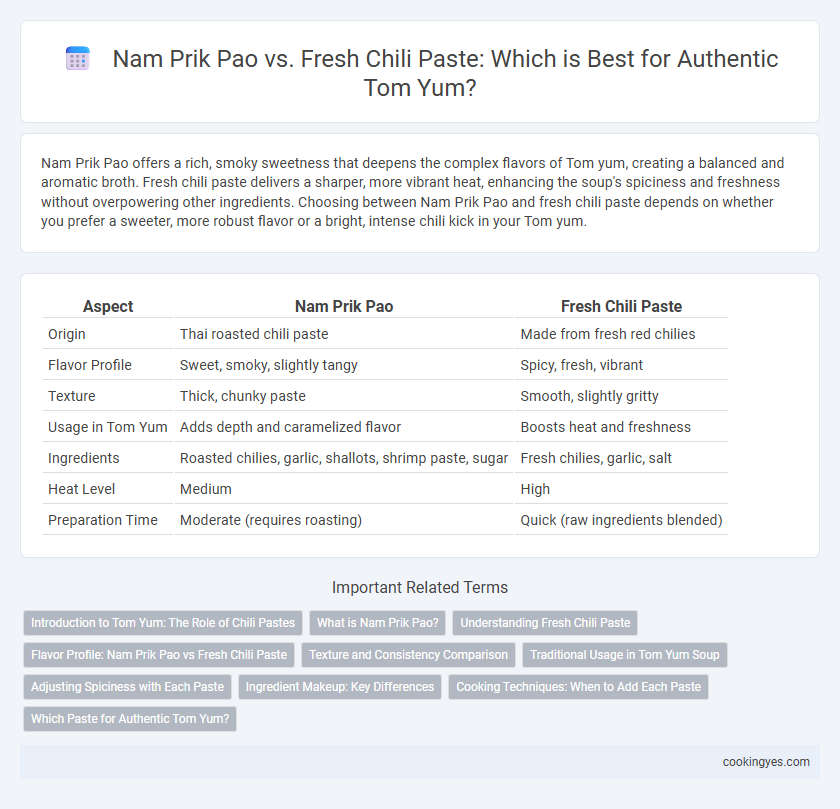Nam Prik Pao offers a rich, smoky sweetness that deepens the complex flavors of Tom yum, creating a balanced and aromatic broth. Fresh chili paste delivers a sharper, more vibrant heat, enhancing the soup's spiciness and freshness without overpowering other ingredients. Choosing between Nam Prik Pao and fresh chili paste depends on whether you prefer a sweeter, more robust flavor or a bright, intense chili kick in your Tom yum.
Table of Comparison
| Aspect | Nam Prik Pao | Fresh Chili Paste |
|---|---|---|
| Origin | Thai roasted chili paste | Made from fresh red chilies |
| Flavor Profile | Sweet, smoky, slightly tangy | Spicy, fresh, vibrant |
| Texture | Thick, chunky paste | Smooth, slightly gritty |
| Usage in Tom Yum | Adds depth and caramelized flavor | Boosts heat and freshness |
| Ingredients | Roasted chilies, garlic, shallots, shrimp paste, sugar | Fresh chilies, garlic, salt |
| Heat Level | Medium | High |
| Preparation Time | Moderate (requires roasting) | Quick (raw ingredients blended) |
Introduction to Tom Yum: The Role of Chili Pastes
Tom yum is a traditional Thai soup known for its bold, spicy, and sour flavors, with chili pastes playing a crucial role in defining its signature taste. Nam Prik Pao, a roasted chili paste made from dried chilies, garlic, shallots, and shrimp paste, imparts a smoky, sweet, and complex depth to the broth. Fresh chili paste, prepared from raw chilies and aromatics, delivers a brighter, sharper heat that intensifies the soup's vibrant, zesty character.
What is Nam Prik Pao?
Nam Prik Pao is a Thai roasted chili paste made from dried chilies, shallots, garlic, shrimp paste, and tamarind, offering a smoky, sweet, and savory flavor essential in authentic Tom Yum soup. Unlike fresh chili paste, which emphasizes the bright heat of raw chilies, Nam Prik Pao provides depth and complexity through its caramelized ingredients and fermentation process. Its unique balance enhances Tom Yum's signature spicy and sour profile while adding subtle umami richness.
Understanding Fresh Chili Paste
Fresh chili paste enhances Tom yum by delivering vibrant, aromatic flavors and a balanced heat, offering a more authentic taste compared to Nam Prik Pao. Made from freshly ground chilies, garlic, shallots, and kaffir lime leaves, fresh chili paste preserves natural textures and pungency. This paste intensifies the soup's spiciness and complexity, creating a dynamic and refreshing profile that highlights traditional Thai culinary techniques.
Flavor Profile: Nam Prik Pao vs Fresh Chili Paste
Nam Prik Pao offers a complex flavor profile with smoky, sweet, and slightly tangy notes, enhancing Tom Yum with depth and a rich umami character. Fresh chili paste provides a vibrant, sharp heat with a fresher, more pungent chili flavor that intensifies the soup's spiciness. Combining both ingredients balances sweetness, smokiness, and fresh heat, creating a multidimensional taste experience in Tom Yum.
Texture and Consistency Comparison
Nam Prik Pao offers a thicker, slightly chunky texture with caramelized bits providing a rich, smoky consistency ideal for deep flavor infusion in Tom Yum. Fresh chili paste delivers a fresher, smoother, and more vibrant paste with a lighter consistency that enhances the soup's brightness without overpowering its balance. The choice between the two depends on whether the desired Tom Yum texture is a robust, hearty base or a clean, spicy clarity.
Traditional Usage in Tom Yum Soup
Nam Prik Pao, a traditional roasted chili paste, imparts a smoky, sweet, and complex flavor essential for authentic tom yum soup, enhancing its rich, tangy broth. Fresh chili paste contributes vibrant heat and freshness but lacks the depth and caramelized notes crucial in classic recipes. Traditional tom yum preparation emphasizes Nam Prik Pao to balance sour, spicy, and savory elements, creating the iconic harmonious taste.
Adjusting Spiciness with Each Paste
Nam Prik Pao offers a smoky, slightly sweet flavor that enhances Tom Yum while providing moderate heat, making it ideal for those seeking balanced spiciness. Fresh chili paste delivers intense, sharp heat with a fresher chili flavor, perfect for adjusting Tom Yum to a more fiery taste. Using Nam Prik Pao allows for controlled, savory spiciness, whereas fresh chili paste enables precise heat adjustments based on the chili variety and quantity used.
Ingredient Makeup: Key Differences
Nam Prik Pao for Tom Yum features a rich blend of roasted chilies, garlic, shallots, and tamarind paste, creating a smoky, sweet, and slightly tangy flavor profile. Fresh chili paste, on the other hand, relies heavily on raw fresh chilies, garlic, and lemongrass, offering a more vibrant, pungent, and intensely spicy taste. The roasting process in Nam Prik Pao caramelizes sugars and deepens flavors, whereas fresh chili paste maintains a bright, crisp heat essential for a lively Tom Yum broth.
Cooking Techniques: When to Add Each Paste
Nam Prik Pao is typically added during the initial stages of cooking Tom Yum to develop a deep, rich flavor base through frying the paste in oil, which enhances its smoky sweetness. Fresh chili paste, made from raw ingredients, is often introduced later in the cooking process or just before serving to preserve its vibrant heat and fresh chili aroma. Selecting the right timing for each paste maximizes the complex interplay of smoky and fresh flavors essential to authentic Tom Yum.
Which Paste for Authentic Tom Yum?
Nam Prik Pao is traditionally preferred for authentic Tom Yum because its roasted chili, garlic, and tamarind blend delivers a smoky, rich depth that defines the classic flavor profile. Fresh chili paste, while vibrant and spicy, lacks the caramelized complexity needed to achieve the signature balance of sour, sweet, and savory tastes. Using Nam Prik Pao ensures the broth embodies the nuanced umami and aromatic qualities central to genuine Tom Yum.
Nam Prik Pao vs Fresh Chili Paste for Tom yum Infographic

 cookingyes.com
cookingyes.com